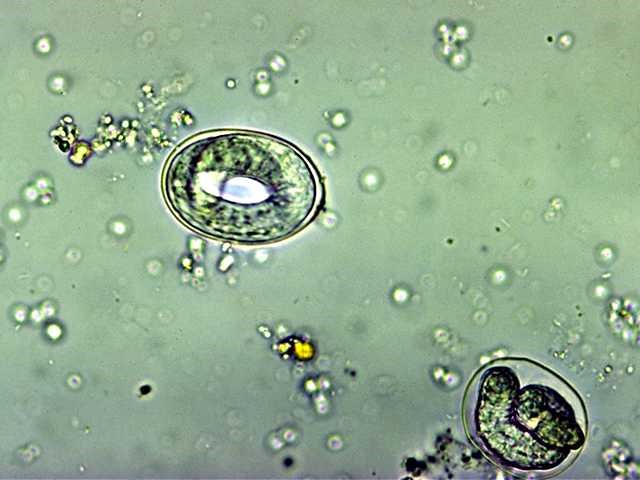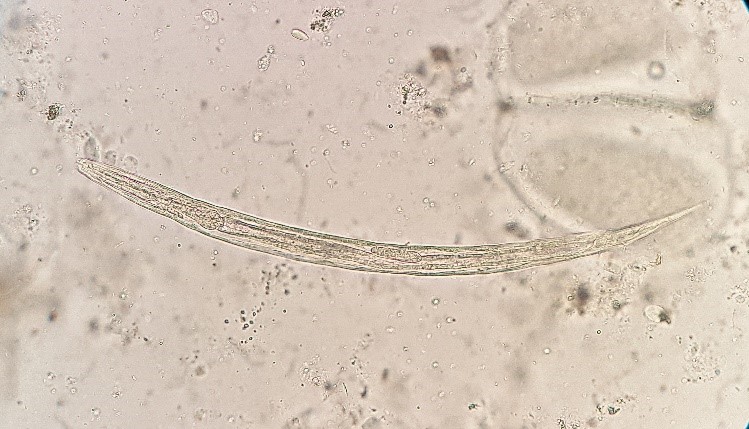Threadworm
(Strongyloides spp.)
Strongyloides spp. are nematodes that may infect wild and domestic carnivores, including cats. Strongyloides stercoralis is zoonotic.
Distribution
Strongyloides planiceps infections in cats have been reported mainly in Japan and Malaysia. Strongyloides felis has been reported in India and Australia. Strongyloides tumefaciens has been reported in North America and India. Cases of Strongyloides infections in cats have been reported in Africa, Europe, Southeast Asia, the Caribbean and South America [1,2,3]; in some cases, the species has been determined as S. stercoralis [2].
Clinical signs
Strongyloides infections in cats are usually asymptomatic and self-limiting. Strongyloides tumefaciens infections or aberrant location of S. stercoralis may produce tumour-like nodules in the large intestine as well as loose or diarrheic faeces.

Figure 1. Strongyloides spp. eggs containing first stage larvae on faecal flotation (Image credit: The University of Melbourne parasitology image library)

Figure 2. Strongyloides stercoralis rhabditiform larva with prominent genital primordium (arrow) in stool, isolated using Baermmann technique (Image credit: shutterstock)
Diagnosis
Strongyloides planiceps infections in cats can be confirmed by standard faecal flotation (SOP 1). Eggs of S. planiceps are 58-64 x 32-40 μm [4] and embryonated when passed (Fig. 1). For other species, the zinc sulphate centrifugal flotation (SOP 2) or the Baermann method (SOP 3) are recommended for detecting larvae (Fig. 2). While Strongyloides larvae can be found in fresh faecal smears, this method is not recommended due to its low sensitivity. In general, faecal examination for Strongyloides spp. can be challenging.
Treatment
There are no approved treatments for Strongyloides spp. infections in cats. Ivermectin (200 μg/kg SC) is anecdotally effective [4]. Thiabendazole (25 mg/kg PO BID for 2 days) was effective against S. felis in three cats [4].
Prevention and Control
Controlling and preventing Strongyloides infections in cats is difficult, considering that the principal route of transmission is through the direct penetration of the skin with larvae.
For further control options refer to the General Considerations and Recommendations section of these guidelines.
Public health considerations
Strongyloides stercoralis is zoonotic. This species is primarily associated with dogs, humans, non-human primates and wild canids [1]. It has been shown experimentally that cats are susceptible to S. stercoralis and cases of alleged S. stercoralis infection in cats have been published [2].
The zoonotic potential of other cat-associated Strongyloides spp. is unknown.
References
[1] Thamsborg SM, Ketzis J, Horii Y, Matthews JB. Strongyloides spp. infections of veterinary importance. Parasitology. 2017;144:274-284.
[2] Nyambura Njuguna A, Kagira JM, Muturi Karanja S, Ngotho M, Mutharia L, Wangari Maina N. Prevalence of Toxoplasma gondii and other gastrointestinal parasites in domestic cats from households in Thika Region, Kenya. Biomed Res Int. 2017;7615810.
[3] Rojekittikhun W et al., Gastrointestinal parasites of dogs and cats in a refuge in Nakhon Nayok, Thailand. Southeast Asian J Trop Med Public Health. 2014;45:31-39.
[4] Bowman DD, Hendrix CM, Lindsay DS, Barr SC. Feline Clinical Parasitology. Iowa State University Press, Ames, USA. 2002.
